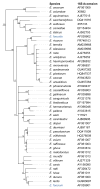Genomic transition of enterococci from gut commensals to leading causes of multidrug-resistant hospital infection in the antibiotic era
- PMID: 23395351
- PMCID: PMC3649759
- DOI: 10.1016/j.mib.2013.01.006
Genomic transition of enterococci from gut commensals to leading causes of multidrug-resistant hospital infection in the antibiotic era
Abstract
The enterococci evolved over eons as highly adapted members of gastrointestinal consortia of a wide variety of hosts, but for reasons that are not entirely clear, emerged in the 1970s as leading causes of multidrug resistant hospital infection. Hospital-adapted pathogenic isolates are characterized by the presence of multiple mobile elements conferring antibiotic resistance, as well as pathogenicity islands, capsule loci and other variable traits. Enterococci may have been primed to emerge among the vanguard of antibiotic resistant strains because of their occurrence in the GI tracts of insects and simple organisms living and feeding on organic matter that is colonized by antibiotic resistant, antibiotic producing micro-organisms. In response to the opportunity to inhabit a new niche--the antibiotic treated hospital patient--the enterococcal genome is evolving in a pattern characteristic of other bacteria that have emerged as pathogens because of opportunities stemming from anthropogenic change.
Copyright © 2013 Elsevier Ltd. All rights reserved.
Figures



References
-
- Hidron AI, Edwards JR, Patel J, Horan TC, Sievert DM, Pollock DA, Fridkin SK National Healthcare Safety Network Team and Participating National Healthcare Safety Network Facilities. NHSN Annual Update-Antimicrobial-Resistant Pathogens Associated With Healthcare-Associated Infections: Annual Summary of Data Reported to the National Healthcare Safety Network at the Centers for Disease Control and Prevention, 2006–2007. Infect Control Hosp Epidemiol. 2008;29:996–1011. - PubMed
-
- Werner G, Coque TM, Hammerum AM, Hope R, Hryniewicz W, Johnson A, Klare I, Kristinsson KG, Leclercq R, Lester CH, Lillie M, Novais C, Olsson-Liljequist B, Peixe LV, Sadowy E, Simonsen GS, Top J, Vuopio-Varkila J, Willems RJ, Witte W, Woodford N. Emergence and spread of vancomycin resistance among enterococci in Europe. Euro Surveill. 2008;13(47):pii, 19046. - PubMed
Publication types
MeSH terms
Substances
Grants and funding
LinkOut - more resources
Full Text Sources
Other Literature Sources

